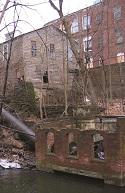

Of course, it doesn’t serve anyone’s interest for these facilities to continue to go un- or under-utilized. The facilities’ owners generally still have to maintain their properties and pay taxes on land and facilities that aren’t producing an income. There can also be significant security costs associated with empty and unused properties. At the same time, the communities in which they are located suffer from the loss of local jobs and reduced tax revenues. And of course, environmentally contaminated land can also pose significant health risks within the local community.
Clearly, it’s in everyone’s interest to restore these properties. The question is, how can it be done? In many cases, traditional design/bid/build approaches can be far too costly. The problem is many owners give up on restoring their properties because they don’t realize there may be better options available than traditional restoration approaches.
An Ideal Solution
For many, design/build can be an ideal solution. Design/build differs from traditional development because there is a single consultant who is responsible for a project from beginning to end and the owner has greater input than with a classic approach.

With design/build, on the other hand, a single consultant is responsible for the entire project from initial design through final construction. All other consultants answer to the design/build leader and as design moves forward, each of the team members has an opportunity to offer feedback. As a result, adjustments happen in the earliest stages of development and the varied project elements are much more likely to mesh seamlessly together.
Many owners are hesitant to take a design/build approach for a variety of reasons. For instance, many mistakenly believe it is more costly. In fact, design/build is typically far more cost-effective than traditional approaches. That’s because it’s a more hands-on approach through which owners and their design/build leaders manage every aspect of design and construction. This significantly reduces the risk of late-stage surprises — particularly unanticipated costs.
Another reason owners tend to avoid design/build is tradition. It’s natural to be more comfortable with what you are used to and owners tend to gravitate to design/bid/build approaches because that’s the way they’ve always pursued development. However, by creating a singular point of responsibility, design/build can effectively integrate the entire design and construction process from start to finish. Strong relationships form between all the members of the team, effective channels of communication are created and everyone fully understands the core mission of the project. Needless to say, once owners try design/build, it doesn’t take long for them to become comfortable with it and the many advantages it offers.
Finally, design/build offers the advantage of speed. Because every member of the team is involved from day one, there are no delays caused by architectural and engineering plans having to be adjusted to work together. Likewise, construction managers are able to offer insights as soon as engineering and architectural elements are introduced rather than having those elements dropped on them in a finished design. This can be invaluable when the design elements aren’t feasible from a construction point of view. Lengthy revision processes don’t occur with design/build because every member of the team is able to provide his or her expertise throughout the design process.

Design/build can also provide extraordinary environmental benefits. This is a particularly important issue at facilities where contamination is an issue. Contamination mitigation can represent an enormous expense in restoring old or out-of-commission industrial sites. In fact, having to identify and safely remove contaminants is often the primary budget buster, and it’s the primary reason that many industrial sites sit empty and abandoned today.
The answer for many is a remediation methodology known as site enabling. Site enabling is a design/build approach through which environmental remediation is an essential element of the overall project. With traditional approaches, environmental consultants often work as a discrete unit, working to identify contaminants and recommend strategies on their own — and separate from the work being done by the rest of the team. The problem is those remediation strategies may not work well with the design and construction strategies already being pursued by the development team. This lack of synergy can lead to costly and time-consuming setbacks, with the development team having to undo the work they’ve already done to accommodate the environmental plan.
With site enabling, on the other hand, the environmental consultants and the design/build leaders are one and the same or are at least members of the same team. Environmental identification and mitigation happens hand-in-hand with primary engineering, architectural design and construction preparation. Again, there are no surprises because every member of the team is on the same page from day one. Environmental challenges are addressed in the initial design stages and designs can be adjusted on the fly as circumstances require.
A Case in Point
The Sherwood Mills Redevelopment in Kensington, Connecticut, offers a good example of the advantages of design/build and site enabling. For over a century, the Sherwood Mills complex manufactured paper cups and other paper products. When production stopped, the complex quickly fell into disrepair.
 The mill’s owners wanted to convert the space for residential use, but environmental and cost questions posed challenges that threatened to undermine the project. The owners decided to pursue a design/build approach that began with site enabling. In the initial stages, an environmental investigation was conducted to determine what types of contaminants were present, after which a mitigation strategy would be developed and implemented. The Phase 1 environmental investigation detected many contaminants that are common in industrial sites, including processed waste, many different types of metals and petroleum hydrocarbons.
The mill’s owners wanted to convert the space for residential use, but environmental and cost questions posed challenges that threatened to undermine the project. The owners decided to pursue a design/build approach that began with site enabling. In the initial stages, an environmental investigation was conducted to determine what types of contaminants were present, after which a mitigation strategy would be developed and implemented. The Phase 1 environmental investigation detected many contaminants that are common in industrial sites, including processed waste, many different types of metals and petroleum hydrocarbons.
Since a design/build approach was being pursued, the team was able to consider all of the environmental requirements as the engineering and architectural design was being completed and as the construction team was making its preparations. Ultimately, there were several environmental challenges that had to be addressed.
First, the team had to decide whether to remove the contaminated soil or cap it. The cost implications were significant. Removing and safely disposing of the contaminated soil would be extremely costly and time-consuming. Conversely, capping it would be an extremely complicated procedure. Engineers would need to design and create a system to assure that the contaminants wouldn’t seep into the adjacent Mattabesset River. At the same time, utilities and other infrastructure would have to be located at least partially within the area containing sealed contaminants and it was essential to assure that contaminants wouldn’t compromise the utilities or escape through utility corridors.
Because it was a design/build project, the team had much more flexibility than with traditional approaches. The civil engineers on the project were able to work much more closely with environmental engineers to cooperate in the development of a complete engineering solution. With a traditional approach, on the other hand, civil engineers would have had to wait for the environmental team to do their work and then revise their plans to adhere to the newly created landscape.
Ultimately, the team settled on a solution through which 3,500 cubic yards of contaminated soil was deposited on-site, behind a retaining wall separating the site from the Mattabesset River. The contaminated soil was then placed upon an impervious liner cap to seal the contaminants and then covered with an additional two to four feet of clean soil. In addition to providing a clean, cost-effective solution, this approach also created a level area on which parking lots could be developed. It also cut the cost of dealing with the contaminated soil by 75 percent.

As the case of the Sherwood Mills complex demonstrates, design/build can be a good solution, not just for bringing facilities back online, but for repurposing them, as well. In this case, the project was repurposed as housing, but it could have been any kind of corporate real estate as well. The flexibility that design/build provides owners and their design teams can make it easier to quickly get facilities up and running again or to create an entirely new vision for how the space will be used.
Reclaiming Underutilized Facilities
At a time when thousands of industrial and commercial sites sit abandoned or underutilized, design/build can provide an attractive option for reclaiming those sites. The significant cost and time savings associated with design/build offer a significant advantage, particularly for properties that have been deemed too expensive to fix. Because owners are leading members of a successful design/build team, they also have much more control over the process (and finished result) than they do with traditional approaches. As a result, owners have more direct influence over the finished product, and they face far fewer surprises. Nobody likes to face unexpected design modifications or expenses and design/build dramatically minimizes the risk of both.
As the Sherwood Mills project in Kensington, Connecticut, dramatically illustrates, design/build can provide the perfect solution for managing difficult restoration projects, particularly those posing complex environmental challenges.


